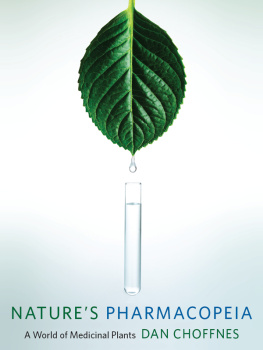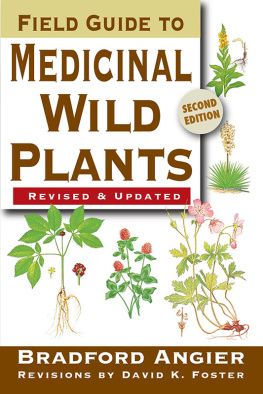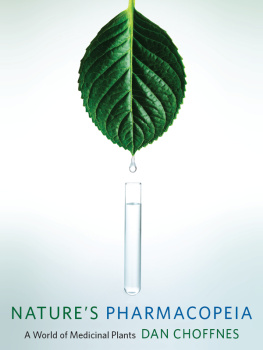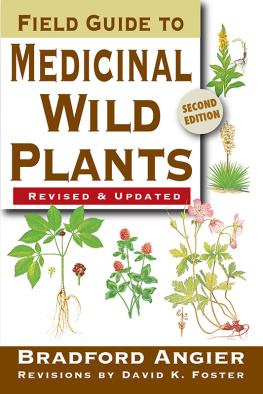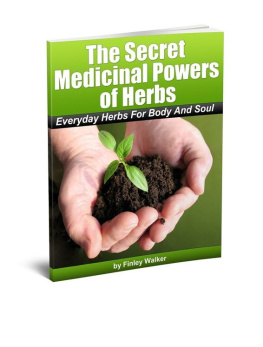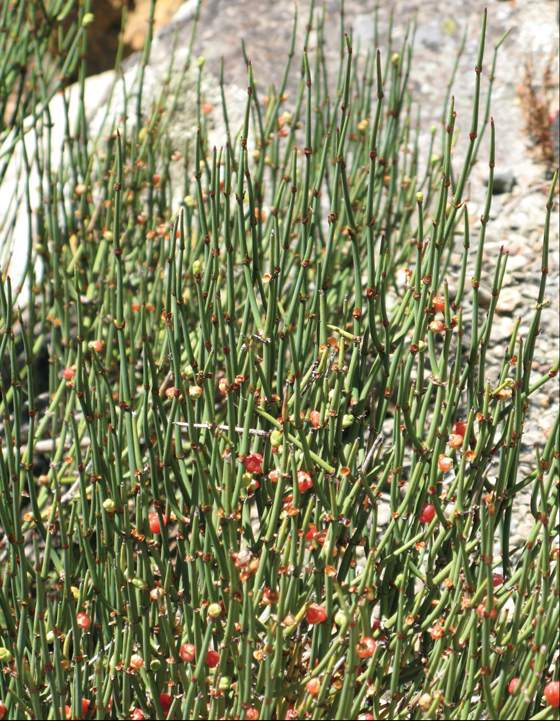Table of Contents
Natures Pharmacopeia
NATURES PHARMACOPEIA
A World of Medicinal Plants
DAN CHOFFNES
COLUMBIA UNIVERSITY PRESS
New York
Columbia University Press
Publishers Since 1893
New York Chichester, West Sussex
cup.columbia.edu
Copyright 2016 Dan Choffnes
All rights reserved
EISBN 978-0-231-54015-5
Library of Congress Cataloging-in-Publication Data
Choffnes, Dan, author.
Natures pharmacopeia : a world of medicinal plants / Dan Choffnes.
p. ; cm.
Includes bibliographical references and index.
ISBN 978-0-231-16660-7 (cloth : alk. paper)
ISBN 978-0-231-16661-4 (pbk. : alk. paper)
ISBN 978-0-231-54015-5 (e-book)
I. Title.
[DNLM: 1. Plants, Medicinal. 2. Ethnobotanyhistory. 3. Phytotherapy. QV 766]
RS164
615.321dc23
2015020788
A Columbia University Press E-book.
CUP would be pleased to hear about your reading experience with this e-book at .
COVER DESIGN: Milenda Nan Ok Lee
COVER IMAGE: @ Getty Images
References to Web sites (URLs) were accurate at the time of writing.
Neither the author nor Columbia University Press is responsible for URLs that may have expired or changed since the manuscript was prepared.
Contents
Not far from the Madre de Dios River in eastern Peru, deep in a jungle rich with life, a gardener tends a plot of semiwild forest, where he propagates and protects several hundred types of medicinally useful plants. I approached his homestead on a dirt road rutted by the passing of motorcycles heavily laden with canvas sacks of Brazil nuts (Bertholletia excelsa) liberated from the dense wilderness and destined for grocery store shelves around the world. He met me at the mouth of a narrow path wearing calf-high rubber boots, and I followed him past all sorts of ferns, palms, and bromeliads, stepping over leaf-cutter ant trails, and toward an enduring education.
I was drawn to this place by the gardeners reputation. He was known throughout the region for his skill in collecting and maintaining living botanical specimens as well as for his ability to prepare remedies from what he harvests. As we walked through the forest, he pointed out plants useful for coughs, for skin problems, as insect repellents, and to treat joint pain. He also ran through recipes: take seven pieces of the stem from this plant, boil together in water with nine leaves from this other plant, and so on. This mans knowledge was rich.
Maestro, I asked, how did you learn all this about these plants?
The plants taught me, he responded.
What can I learn from the plants, I wondered, about their histories, their healthful and harmful properties, their chemistries, the ways that they intertwine themselves in our cultures? I wrote this book as an introduction to these topics, a point of departure for deeper study among those so inclined. These few stories about a handful of medicinal plants give just a glimpse into our long relationships with them.
As I learn from the plants, I am also grateful to my numerous teachers, the men and women who use medicinal herbs in traditional settings and have been generous to share some of what they know with me. I continue to learn so much from the work of countless researchers and scholars who have published their research, from among indigenous peoples, from the clinic, from the laboratory, and from archives, guiding me through the multiple facets and unending stories of medicinal plants.
The tales of these plants are woven into many aspects of human affairs. Readers will recognize threads of geopolitics, of social conflict, of the sacred, of the profane, and of an ongoing conversation about just what distinguishes a medicine from a drug of abuse. Many of these plants have psychoactive properties, their effects recognized early in human history and their biological mechanisms deeply explored.
I chose to write this book for a reader with little background in the topics considered. Those interested in pursuing the botany, pharmacology, and biochemistry of medicinal plants in greater depth are invited to seek out the cited works and other important contributions in these fields. Likewise, the historical passages can serve as impetus for a more serious study of primary and secondary sources on these subjects. Nor does this book substantially address clinical matters, for which there is a rich and fascinating literature. I regret that some readers may be disappointed by the limited space given to certain topics and by the decision to address broad themes at the expense of detailed analysis. While new data about medicinal plants and their properties have emerged daily from laboratories around the world, I generally avoided the temptation to present a comprehensive and up-to-the-minute account of new findings. As many important scientific studies have not been included in this book, interested readers will satisfy their curiosity in the pages of more expansive publications and in scientific journal articles. Finally, I will note that there are numerous widely consumed medicinal plants whose stories I could not contain in these chapters.
I am indebted to several anonymous reviewers whose suggestions have improved this manuscript. The organization and selection of themes benefited from the advice of many experts in the field, but in the end, I am responsible for any remaining lacunae and errors in the text. I would therefore appreciate hearing from readers to refine the content of the book.
Thank you to Amber Petersen, Jennifer Bickle, Christina Konecki, Josh Neukom, Nathalie Bolduc, and Julio Ramirez for their contributions to this manuscript at various stages, and to Michael Maher especially for his generous assistance with figures. For essential help, my appreciation to Mr. C.
I am grateful to Jonathan Marshall, Wenjie Sun, Paul Martino, Dan Miller, Penny Seymoure, and Jeff Roberg for such kind support over many years, to ASIANetwork for nurturing Asian Studies in the liberal arts, and to Judith Farquhar for much inspiration and assistance. I owe a lot also to Lila Vodkin, Don Briskin, and Jennifer Fletcher.
This project would have taken a much steeper path if not for the phenomenal skills of Kathy Myers, librarian extraordinaire. Patrick Fitzgerald, Kathryn Schell, and Bridget Flannery-McCoy at Columbia University Press skillfully guided this text from manuscript to published book. Thanks also to Milenda Lee, Irene Pavitt, and Robert Fellman.
To my partner, counselor, and collaborator on so many things, Winnie, my most profound appreciation. For all that is possible, Nicole and Alexander.
The information provided in this book is for educational, scientific, and cultural interest only and should not be construed as medical advice or as advocacy for the current use of medicinal plants under any circumstances outside of settings where their use is legally sanctioned by medical professionals. Neither the author nor the publisher assumes any responsibility for physical, psychological, legal or other consequences arising from use of these medicinal plants.

